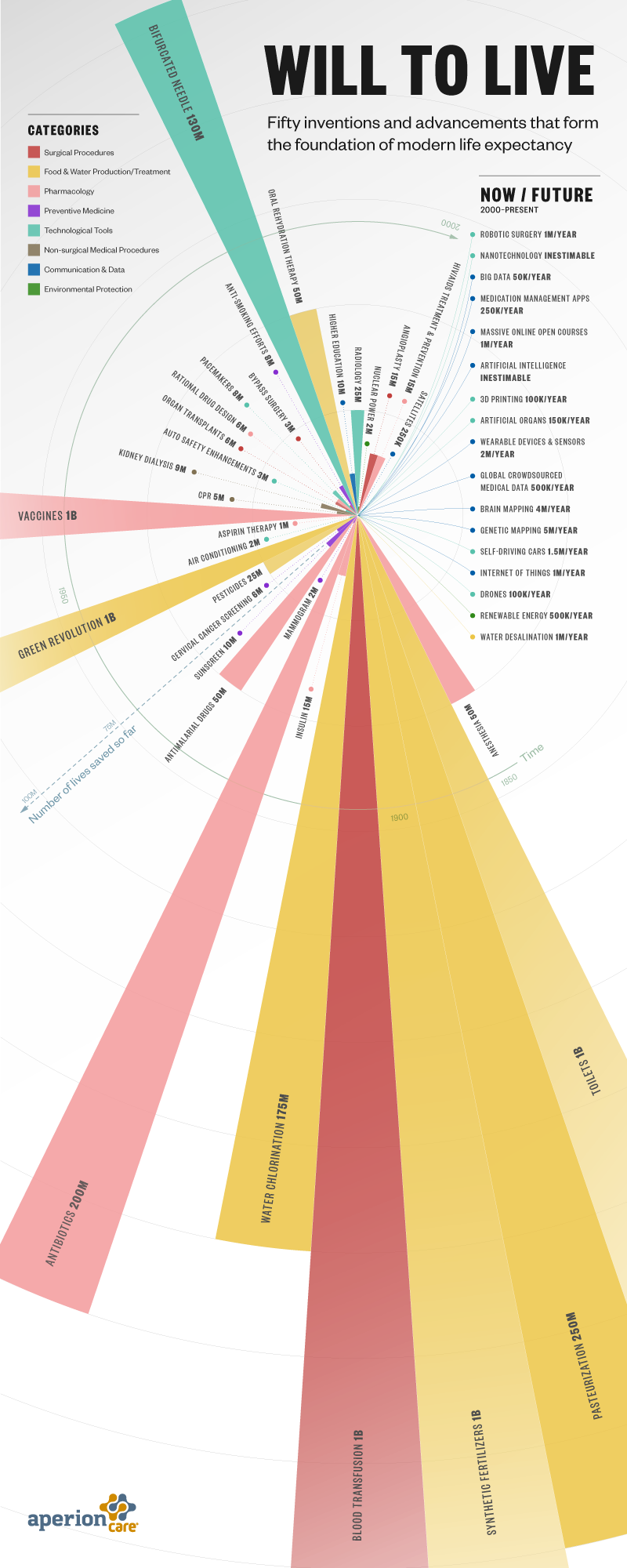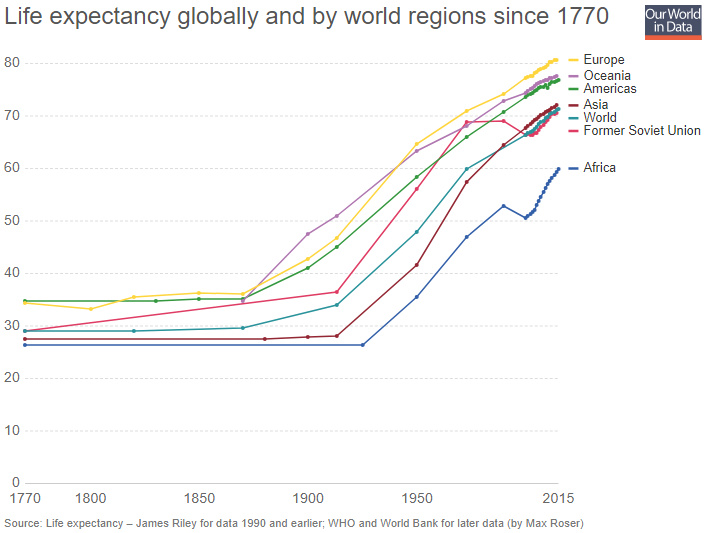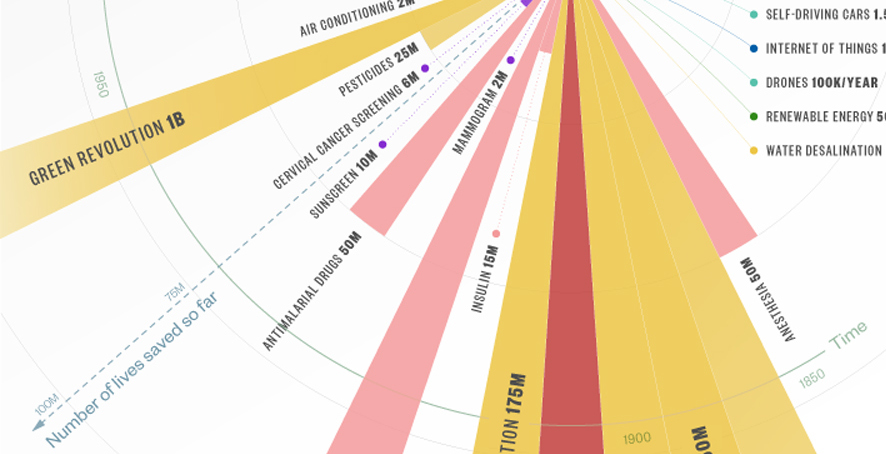Technology
The 50 Most Important Life-Saving Breakthroughs in History

The 50 Most Important Life-Saving Breakthroughs in History
For most of civilized history, life expectancy fluctuated in the 30 to 40 year range.
Child mortality was all too common, and even for those that made it to adulthood, a long and healthy life was anything but guaranteed. Sanitation was poor, disease was rampant, and many medical practices were based primarily on superstition or guesswork.
By the 20th century, an explosion in new technologies, treatments, and other science-backed practices helped to increase global life expectancy at an unprecedented rate.
From 1900 to 2015, global life expectancy more than doubled, shooting well past the 70 year mark.
Important Breakthroughs
What were the major innovations that made the last century so very fruitful in saving lives?
Today’s infographic from AperionCare highlights the top 50 breakthroughs, ranging from pasteurization to the bifurcated needle, that have helped propel global life expectancy upwards.
Interestingly, while many of these innovations have some linkage to the medical realm, there are also breakthroughs in sectors like energy, sanitation, and agriculture that have helped us lead longer and healthier lives.
To see innovations on an individual basis, AperionCare breaks them down further as follows:

The breakthroughs that are credited with saving the most lives?
Toilets, synthetic fertilizers, blood transfusions, the green revolution (also known as the “Third Agricultural Revolution”), and vaccines are each credited with saving 1 billion lives. Meanwhile, pasteurization, water chlorination, antibiotics, antimalarial drugs, and the bifurcated needle have saved hundreds of millions of lives each.
There are also some unusual entries to the list.
It turns out that satellites have actually saved 250,000 lives, thanks to the ability to better forecast natural disasters. Nuclear power also gets a shout out – and it may surprise some people that nuclear energy is the least deadly form of energy per kilowatt generated.
Progress in Life Expectancy
For a graphical look at how this all has impacted life expectancy, the following chart from Our World in Data makes a very clear case:

The impact from these new technologies was first experienced in Europe at the end of the 1800s – and other continents quickly saw the benefits thereafter.
Impressively, Africa has now passed the 60 year mark in life expectancy, with numbers still rising.
Technology
All of the Grants Given by the U.S. CHIPS Act
Intel, TSMC, and more have received billions in subsidies from the U.S. CHIPS Act in 2024.

All of the Grants Given by the U.S. CHIPS Act
This was originally posted on our Voronoi app. Download the app for free on iOS or Android and discover incredible data-driven charts from a variety of trusted sources.
This visualization shows which companies are receiving grants from the U.S. CHIPS Act, as of April 25, 2024. The CHIPS Act is a federal statute signed into law by President Joe Biden that authorizes $280 billion in new funding to boost domestic research and manufacturing of semiconductors.
The grant amounts visualized in this graphic are intended to accelerate the production of semiconductor fabrication plants (fabs) across the United States.
Data and Company Highlights
The figures we used to create this graphic were collected from a variety of public news sources. The Semiconductor Industry Association (SIA) also maintains a tracker for CHIPS Act recipients, though at the time of writing it does not have the latest details for Micron.
| Company | Federal Grant Amount | Anticipated Investment From Company |
|---|---|---|
| 🇺🇸 Intel | $8,500,000,000 | $100,000,000,000 |
| 🇹🇼 TSMC | $6,600,000,000 | $65,000,000,000 |
| 🇰🇷 Samsung | $6,400,000,000 | $45,000,000,000 |
| 🇺🇸 Micron | $6,100,000,000 | $50,000,000,000 |
| 🇺🇸 GlobalFoundries | $1,500,000,000 | $12,000,000,000 |
| 🇺🇸 Microchip | $162,000,000 | N/A |
| 🇬🇧 BAE Systems | $35,000,000 | N/A |
BAE Systems was not included in the graphic due to size limitations
Intel’s Massive Plans
Intel is receiving the largest share of the pie, with $8.5 billion in grants (plus an additional $11 billion in government loans). This grant accounts for 22% of the CHIPS Act’s total subsidies for chip production.
From Intel’s side, the company is expected to invest $100 billion to construct new fabs in Arizona and Ohio, while modernizing and/or expanding existing fabs in Oregon and New Mexico. Intel could also claim another $25 billion in credits through the U.S. Treasury Department’s Investment Tax Credit.
TSMC Expands its U.S. Presence
TSMC, the world’s largest semiconductor foundry company, is receiving a hefty $6.6 billion to construct a new chip plant with three fabs in Arizona. The Taiwanese chipmaker is expected to invest $65 billion into the project.
The plant’s first fab will be up and running in the first half of 2025, leveraging 4 nm (nanometer) technology. According to TrendForce, the other fabs will produce chips on more advanced 3 nm and 2 nm processes.
The Latest Grant Goes to Micron
Micron, the only U.S.-based manufacturer of memory chips, is set to receive $6.1 billion in grants to support its plans of investing $50 billion through 2030. This investment will be used to construct new fabs in Idaho and New York.
-

 Debt1 week ago
Debt1 week agoHow Debt-to-GDP Ratios Have Changed Since 2000
-

 Markets2 weeks ago
Markets2 weeks agoRanked: The World’s Top Flight Routes, by Revenue
-

 Countries2 weeks ago
Countries2 weeks agoPopulation Projections: The World’s 6 Largest Countries in 2075
-

 Markets2 weeks ago
Markets2 weeks agoThe Top 10 States by Real GDP Growth in 2023
-

 Demographics2 weeks ago
Demographics2 weeks agoThe Smallest Gender Wage Gaps in OECD Countries
-

 United States2 weeks ago
United States2 weeks agoWhere U.S. Inflation Hit the Hardest in March 2024
-

 Green2 weeks ago
Green2 weeks agoTop Countries By Forest Growth Since 2001
-

 United States2 weeks ago
United States2 weeks agoRanked: The Largest U.S. Corporations by Number of Employees















